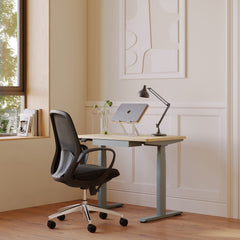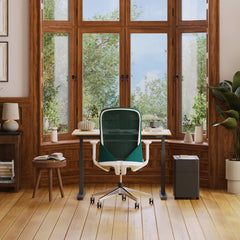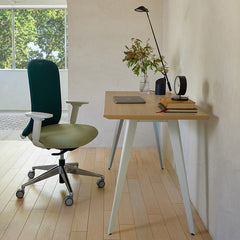Get 10% off your first order
Find the office furniture that’s designed to match your style, comfort, and needs perfectly. Subscribe
Space Shift: The Art of the Live-Work Fusion

Visit quiz page to see how we makes it easy to create an inspiring workplace

For anyone working long hours at a desk, the question of ergonomic chairs vs standing desks eventually comes up. Both claim to solve posture problems, improve comfort, and boost productivity. But which one should you prioritize first if you’re building a healthier workspace?
Workplace ergonomics isn’t just a trendy buzzword — it’s about preventing real, lasting health problems. Poor posture and prolonged sitting have been linked to musculoskeletal disorders, circulation issues, and fatigue. According to the CDC’s ergonomics research, proper workstation design can reduce injury risks and improve comfort across industries.
The massive shift toward remote and hybrid work has forced people to rethink their setups. Dining chairs, couches, or barstools simply don’t cut it for eight-hour workdays. As more employees invest in home offices, the debate between ergonomic chairs and standing desks has become one of the most common starting points.
Despite their popularity, both options are surrounded by myths.
Not necessarily. A standing desk encourages movement, but standing for hours with poor posture can cause strain on knees and lower back. It’s about alternating positions, not standing indefinitely.
Definitely not. Many chairs marketed as “ergonomic” lack the adjustable features needed to truly support different body types and postures. A genuine ergonomic chair adapts to the user, not the other way around.

When comparing ergonomic chairs vs standing desks, chairs often win as the first upgrade for people who spend most of their day sitting.
A well-designed ergonomic chair offers lumbar support, adjustable seat depth, height and tilt settings, cushioned armrests, and breathable fabrics. These features distribute weight evenly and help maintain natural spinal alignment. You can explore various ergonomic chair options tailored to different styles and needs.
Proper support reduces slouching, eases pressure on the spine, and prevents numbness in the legs caused by poor circulation. Over time, this can mean fewer tension headaches, less back stiffness, and improved comfort throughout the day.
Comfortable workers are less distracted. An ergonomic chair reduces the need for constant adjustments, allowing for longer periods of deep focus. For tasks requiring sustained concentration — like coding, writing, or designing — a supportive chair is often more beneficial than a standing desk.
If you spend the majority of your day seated, a supportive chair provides immediate relief and is likely the more practical first purchase.
In apartments or shared spaces where standing desks may not fit, a high-quality chair ensures that even limited workspace supports long-term health.

Standing desks, on the other hand, prioritize movement and flexibility. They’re especially appealing to workers trying to combat the sedentary nature of desk jobs.
Switching between sitting and standing can reduce stiffness, boost circulation, and lower the risks associated with sedentary behavior. Some studies suggest standing more often can improve metabolic health markers and energy expenditure.
Standing promotes alertness, which can be helpful during brainstorming sessions, short calls, or collaborative tasks. Many users find they’re more energized when standing during meetings compared to sitting passively.
Standing desks allow for seamless transitions between sitting, standing, and walking around. This is especially useful for roles that require multitasking or collaboration.
If you already own a solid ergonomic chair but find yourself too sedentary, investing in a standing desk might provide the balance you’re missing.
Height-adjustable desks are now more accessible than ever. From compact sit-stand converters to fully adjustable electric models, you can browse different standing desk styles to suit your workspace.

When it comes to ergonomic chairs vs standing desks, cost and practicality often guide the decision.
Quality ergonomic chairs typically range from mid-tier prices to premium investments, while standing desks can vary widely depending on size and automation features. For many, an ergonomic chair offers a faster return on comfort, while a standing desk may be a second-stage upgrade.
Standing desks can require more clearance and cable management, making them trickier in smaller rooms. Ergonomic chairs, while bulky, are often easier to accommodate with traditional desks.
Your daily habits should guide your purchase. Deep-focus workers often benefit most from chairs first, while those who thrive on movement and energy may lean toward a standing desk. If you’re unsure, consider a hybrid setup. The bundle-building option allows you to mix and match based on your priorities.
The truth is, the best ergonomic setup often involves both.
Alternating between sitting and standing reduces strain, prevents fatigue, and promotes better circulation. This flexibility mirrors natural movement patterns and minimizes the risks of static posture.
These mats reduce pressure on the feet and knees, making standing more comfortable for extended periods.
Extra supports can fine-tune comfort and help adapt chairs to your body.
Browse complementary ergonomic accessories to upgrade either setup.
It’s best to start slow. With standing desks, begin with 20–30 minutes per hour and gradually increase. For ergonomic chairs, make use of adjustable features until you find the most supportive position. Habits take time to form, but consistency pays off.
The conversation about ergonomic chairs vs standing desks is really about the broader future of workplace wellness.
Offices are increasingly integrating flexible workstations, with options for employees to sit or stand based on preference. Home offices are following suit as health-conscious professionals demand more from their setups.
Instead of choosing one or the other, more workers are investing in both over time. Bundled options make it easier to design workspaces that balance comfort, health, and productivity.
Ultimately, your decision depends on where you are right now. If your chair leaves you sore at the end of every workday, upgrade it first. If you already have a solid seat but need more movement, go for the desk. And if you can eventually afford both, you’ll have the best of both worlds.
Ergonomic chairs often provide more immediate relief for back pain by supporting natural spinal alignment. Standing desks can help reduce sedentary behavior, but they don’t replace the need for proper seating support.
If you spend most of your workday seated, an ergonomic chair is usually the smarter first purchase. If you already own a supportive chair but want to add more movement, a standing desk may be the better choice.
No, even with a standing desk, you’ll still need to sit for part of the day. A quality ergonomic chair ensures comfort and reduces strain when you alternate between sitting and standing.
Yes. Combining an ergonomic chair with a standing desk offers the best ergonomic setup by allowing flexibility and reducing the risks of both prolonged sitting and prolonged standing.
Anti-fatigue mats, monitor arms, lumbar pillows, and footrests are common accessories that make both ergonomic chairs and standing desks more comfortable and supportive.

Space Shift: The Art of the Live-Work Fusion

How to Arrange Furniture to Maximize Peace

Crafting Calm: Your Guide to the Perfect Reading Corner
Get 10% off your first order
Find the office furniture that’s designed to match your style, comfort, and needs perfectly. Subscribe
Leave a comment